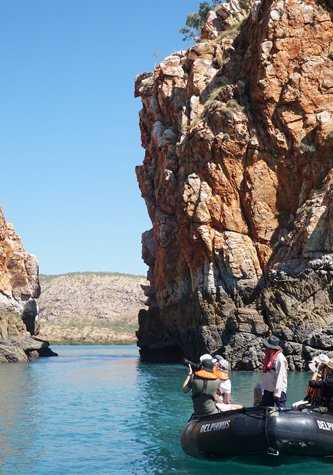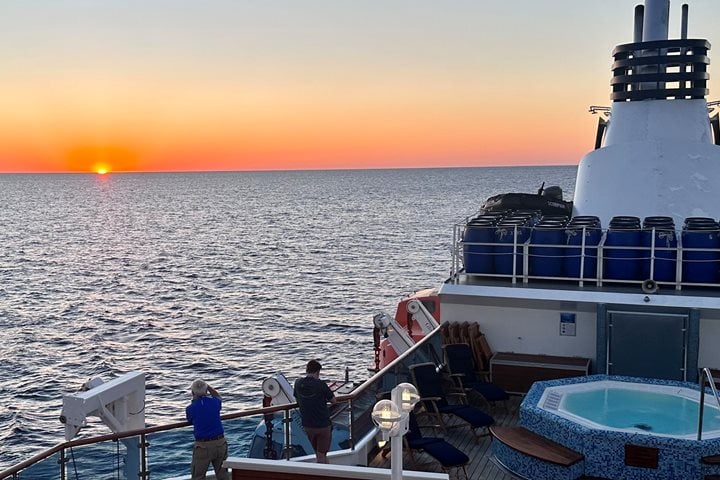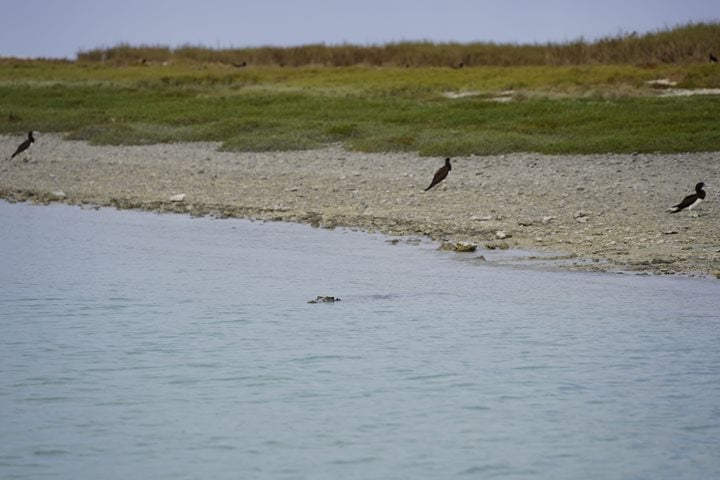In the early hours of this morning National Geographic Orion slipped silently through the Narrows of Talbot Bay’s entrance whilst most on board slept. At anchor, Slug Island sits imposingly along side as breakfast is consumed and Zodiacs hoisted down. Anticipation is running high in direct relationship to the tides.
The day’s first Zodiac excursion sees us heading up the narrow confines of the bay and into Cyclone Creek, not only to explore what biota is on offer, but also to investigate how the geological processes specific to this location have shaped the sandstone plateau. We have now departed from the central section of the Kimberley craton’s plateau where the sandstone laid flat and begin to approach the seaward margin of the King Leopold erogenous zone where two land masses collided. Evident buckling and bending is a testament to the incredible forces that thrust previously horizontal layers of sandstone into vertical and obtuse planes.
Reasonable wet season rainfall in this part of the Kimberley means grasses also grow sufficiently to support short-eared rock wallabies, now recognised as their own species endemic to the Kimberley region. Rocky clefts and cliffs provide the animals with suitable habitat. We also sight Australian humpback dolphins, the ubiquitous Crocodylus porosus (‘salty’) along with fiddler crabs, a wedge-tailed eagle, and numerous other birds in what is truly a birder’s paradise. The exotic Kimberley rose (red kurrajong) is in bloom representing some of the region’s iconic flora.
On the return journey to the boat it is all about the spectacle of the Horizontal Waterfalls. These are gaps in two parallel ridges separating two valleys now flooded by the sea. The ends of the valleys are enclosed and the waters entering cannot escape. The gaps are narrow meaning the tide cannot fill the space on the opposite side from which it approaches in the same time that it rises (or falls). This creates an apparent ‘waterfall’ as the water rushes through to fill the void beyond. Being on the relatively small tidal range of a neap tide, the Horizontal Waterfalls are not displaying their full power today, but the flow is enough to give us an indication of what that might be.
After a quick morning tea we venture out again in the Zodiacs to inspect the falls at slack tide, passing through what was previously an unnavigable passage. We explore the embayment beyond before heading back through as the torrent again picks up as the tide gains momentum.
Back on the boat we have time to relax with yet another impressive and formidable lunch. Some elect to continue with an afternoon of relaxation, content with all the day has presented. Others take to Zodiacs for a trip along the coast of Slug Island, well named for its obvious appearance.
Riding a high tide, we are able to get in amongst the mangroves with clear water providing good vision. The softening afternoon light casts light and shade over the beautiful towing sandstone cliffs and small embayments. High above ospreys soar, along with a nankeen kestrel and a peregrine falcon. At sea level a striated heron is disturbed from some fishing. As we round the top end of Slug, National Geographic Orion slides into view having moved to meet us.
Back on board we are treated to some cocktails on deck 6 while two of the kids on the expedition have a splash in the jacuzzi. The setting sun creates a stunning scene as we slip out through Talbot Bay’s Narrows. We wonder if the Kimberley can keep getting better, but after a day like today we have to consider that it simply can…







